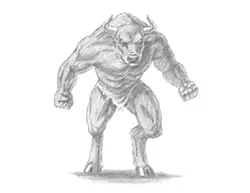
Step 25: Use the angled line on the far left side as a guide to draw the first hind leg. Follow the path of the guide and lightly sketch the leg around it. When you get the shape right, darken the lines. The top of the centaur's leg should be wide. The shape should angle in the middle and at the bottom for the joints. Add the feathers at the bottom using short strokes. Use a line for the hoof at the bottom.

Step 26: Use the last line under the body as a guide to draw the centaur's other hind leg the same way. Use the other hind leg as a template to make this hind leg look similar. Add the joints as curved lines and the feathers at the bottom as short strokes.

Step 27: Use the remaining lines and shapes as guides to draw the rest of the horse body. Simply darken the outer edges of the initial guides to create the shape of the body. Use the line on the left side as a guide to draw the tail. Draw a series of wavy lines around the guide to create the centaur's tail. You can make it as long or as short as you want.

Step 28: For a cleaner look, erase as much as you can of the initial guide lines. Don't worry about erasing all of the guides. It's okay to leave some behind. Re-draw any final sketch lines you may have accidentally erased.

Final Step: Add some shading to your centaur drawing for extra detail. Centaurs are mythical creatures, so you can shade yours however you'd like. You can even color it! For this look, use a dark value for the hair and beard. Leave a few sections on the hair blank for shine. For a more detailed guide on how to shade, check out this tutorial: How to shade.
Now use a light value for the human and the horse body. Use a dark value for the centaur's tail, but like with the hair, leave a few sections blank to represent shine. Leave the feathers blank and use a dark value for the hooves.
Add even more shading to give your centaur drawing more dimension and volume. Pick the direction of the light source when shading so that the shadows are consistent with it. Vary the pressure on your pencil to get different degrees of tonal value. Add the value lightly at first and gradually build up to the level of darkness that you want. Shading can be time-consuming, so be patient and take breaks.
Add a cast shadow underneath. This helps to ground the centaur so it doesn't appear to be floating.
Continue shading until you're satisfied with the end result. Centaurs are mythical, so you can add things like stripes or spots or anything you want to the body!
Don't forget to pause the video after each step to draw at your own pace.
Thanks for visiting! Subscribe to the How2DrawAnimals YouTube Channel for a new tutorial every week.
To learn how to draw popular cartoon characters, visit EasyDrawingTutorials.com.
RELATED TUTORIALS
 |
 |
 |







